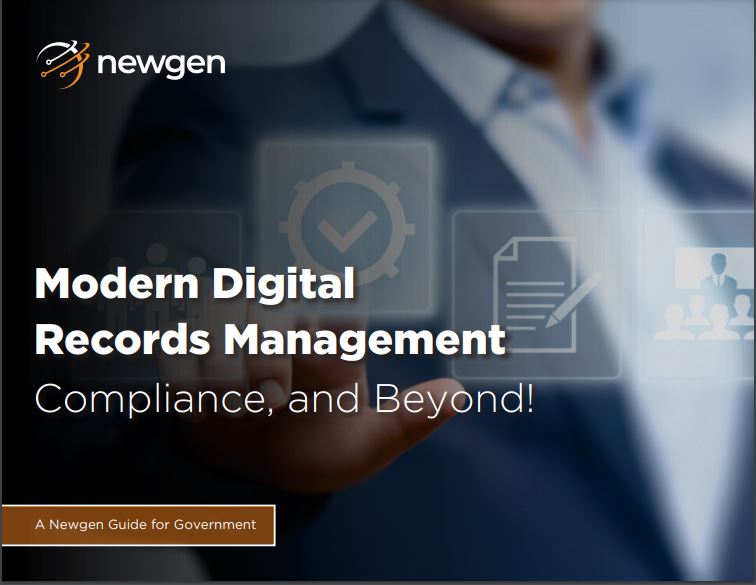The Shift to Digital Governance
Government organizations worldwide are embracing digital transformation to deliver transparent, efficient, and accountable public services. The COVID-19 pandemic accelerated this need, forcing agencies to adopt systems that enable remote work, digital collaboration, and secure access to records.
In this new era, Electronic Documents and Records Management Systems (EDRMS) have become the cornerstone of effective governance. The Newgen EDRMS, powered by AI and ML-based intelligent classification, allows agencies to automatically capture, organize, and securely dispose of records ensuring compliance while improving accessibility and efficiency.
This eBook provides a roadmap for public institutions to move beyond compliance and build modern, intelligent, and scalable records management ecosystems that support innovation and collaboration.
Why Modern Digital Records Management Matters?
Records are the lifeblood of governance. They preserve institutional memory, ensure accountability, and serve as tools for social justice and transparency.
National Archives across the globe mandate that government agencies maintain standardized, secure, and transferable digital records for long-term preservation. This has made digital records transformation a top priority not just for operational efficiency, but also for trust, governance, and citizen engagement.
Key outcomes of modern digital records management include:
- Improved governance and accountability.
- Faster access and retrieval across repositories.
- Secure, centralized content storage.
- Real-time insights and monitoring dashboards.
- AI-driven content classification and analytics.
In short, digital records management is no longer optional it’s foundational to effective governance.
The Challenges in Records Management
While the vision is clear, the path to digital records excellence is complex. Agencies often struggle with:
- Balancing digitization with compliance requirements.
- Managing multiple content types and formats.
- Ensuring security and interoperability across systems.
- Maintaining metadata integrity.
- Scaling in line with new retention schedules.
Addressing these challenges requires strategic planning, advanced technology, and cross-departmental collaboration.
Key Steps to Modernize Records Management
The eBook outlines a nine-step framework for agencies looking to modernize their records management systems and go beyond basic compliance.
1. Define Strategic and Operational Plans
Start with a clear strategy that balances short-term compliance goals with long-term modernization objectives.
- Assess your current automation level and readiness.
- Define 2-year and 5-year milestones.
- Identify early wins and build momentum with parallel operational tracks covering policy, technology, and training.
2. Examine Records Inventory and Taxonomy
Create a unified catalog of all records physical and digital with clearly defined metadata and access rights.
- Establish consistent classification and tagging methods.
- Support hybrid records management for both formats.
- Enable role-based access controls and security.
3. Assess Policies and Procedures
Develop a comprehensive records policy covering the entire lifecycle from creation to archival and destruction.
- Define clear roles and responsibilities.
- Automate workflows to ensure policy adherence.
- Implement audit trails to maintain accountability.
4. Establish Retention Schedules and Disposition
Retention is a cornerstone of compliance.
- Define clear retention timelines and destruction methods.
- Automate archival and disposition processes.
- Ensure flexibility to adapt to changing regulations.
5. Establish a Technology Platform with Digital Capabilities
Select a future-ready platform that unites content management, workflow automation, and compliance.
- Support AI-based classification and metadata generation.
- Enable integration with existing repositories.
- Ensure scalability through cloud-based architecture.
6. Implement an Intelligent EDRMS
Automation and intelligence are key to successful transformation.
- Use RPA and AI to automate document classification and routing.
- Integrate scanning and intelligent extraction early in workflows.
- Ensure seamless search across all repositories.
- Employ hybrid management to handle both digital and physical content.
Outcome: Consistent, secure, and traceable record lifecycle management.
7. Embrace the Future with Extensible Records Management
Records that are “born digital” are quickly becoming the standard.
- Build systems capable of handling social media, email, and digital-born content.
- Map structured metadata correctly for efficient retrieval.
- Enable social records management for digital-native formats.
8. Leverage Cutting-Edge Technologies
Transforming records management requires embracing emerging technologies:
- AI/ML for predictive analytics and classification.
- NLP for contextual search and discovery.
- RPA for automating repetitive processes.
- Cloud for scalability and mobility.
- Microservices and DevOps for flexibility.
Records management should evolve continuously not as a one-time project but as an ongoing digital initiative.
9. Scale and Drive Adoption
True transformation occurs when the entire organization adopts the system seamlessly.
- Focus on user experience through persona-based access.
- Maintain compliance with global standards such as ISO 15489 and ISO 16175.
- Build training programs and awareness campaigns to encourage adoption.
What Success Looks Like?
A successful digital records management initiative leads to:
- Citizen-centric governance with transparent, traceable decisions.
- Connected collaboration across agencies and departments.
- Corruption-resistant archives with end-to-end security.
- Responsive administration with anywhere, anytime access.
When implemented well, records digitization becomes a catalyst for national efficiency, transparency, and heritage preservation.
Newgen’s Modern Digital Records Management Solution
Newgen’s Electronic Documents and Records Management System (EDRMS) empowers government agencies to automate and optimize their entire records lifecycle from creation and classification to archival and disposition.
Key Features:
- AI and ML-based automatic classification.
- End-to-end lifecycle management for physical, electronic, and social records.
- Secure, centralized repository for storage and retrieval.
- Intelligent dashboards and reports for visibility.
- Multi-tenancy and cloud scalability.
- Mobile accessibility for on-the-go record management.
Key Benefits:
- Enhanced governance and public accountability.
- Faster, easier access to vital information.
- Seamless collaboration and version control.
- 100 percent compliance and security assurance.
The Path to Smarter Governance
Digital records management is more than digitization it’s about reimagining how governments operate, collaborate, and serve citizens.
With Newgen’s modern EDRMS, agencies can ensure compliance today and agility for tomorrow, creating a transparent and efficient governance ecosystem built for the digital era.

